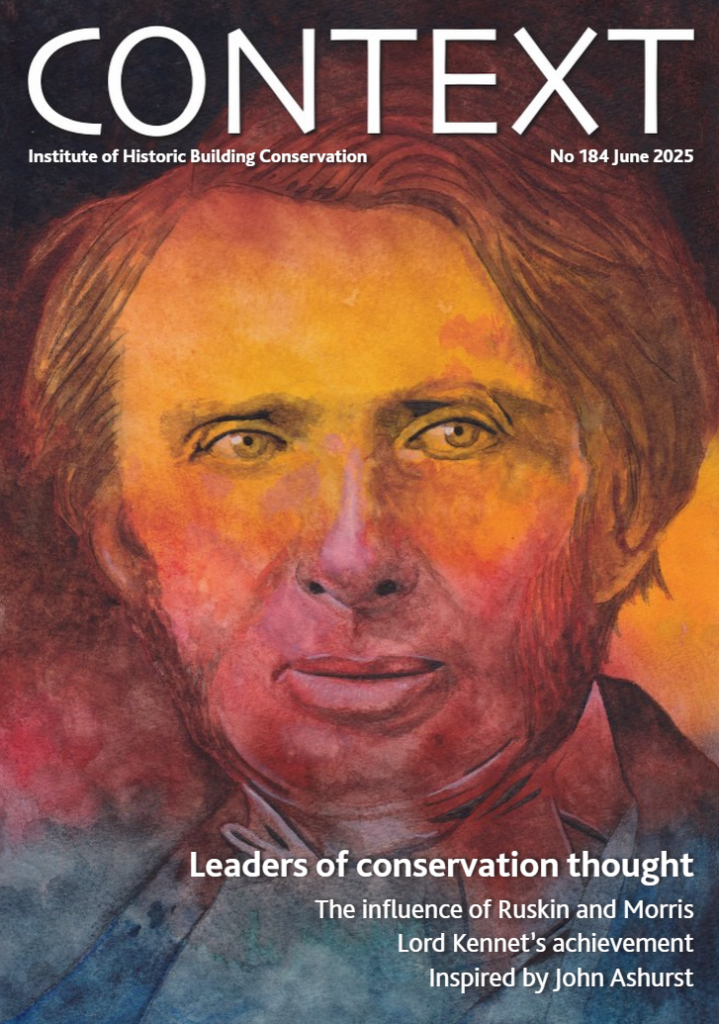
IHBC’s members’ journal Context in June 2025 – No. 184 – focussed on ‘Leaders of conservation thought’, but also included Sammy Woodford on ‘’The world of generative AI’.
Sammy Woodford writes:
For many tasks artificial intelligence (AI) can be of great use to the conservation professional, even if we have little idea of what the risks are or where this tool is taking us.
When people refer to AI these days they are typically referring to ‘generative’ AI (or ‘genAI’)which is AI that generates content. This is based on an invention called a transformer.‘ Generative’ and ‘transformer’ are the G andT in GPT, and the P stands for ‘pretrained’, which refers to the massive amount of training data needed. A transformer is a type of neural network architecture. It was invented in 2017, although the present AI chapter is the latest in a field(deep learning) that has been chugging away quietly in the background for more than60 years, albeit picking up over the past 12
Transformer architecture, in combination with greatly scaled size and training data, has heralded a rapid acceleration in the fields of natural language processing and computer vision. With the 2022 release of ChatGPT, a transformer-based chat bot that can answer questions with levels of sophistication hitherto reserved for science-fiction, the technology entered the public consciousness….
The ability to answer questions across abroad range of topics rather than only specialisms for which they have been trained, and in natural language indistinguishable from that of humans, marks out these ‘large language models’ from their predecessors….
…
The two images in this article were generated completely using the image diffusion service Midjourney. This uses text, or text and images in combination, to produce a picture. The initial image was designed to resemble a photograph of a 1960s office development in an English high street.
Using Midjourney’s ‘inpainting’ tool, in which an area of an image can be selected and re-generated using a different instruction, I carried out the following changes:..
•Replaced the highway in the foreground with a public realm scheme consisting of paving, planters with plants, and wide pavements.
•Replaced two of the central buildings to simulate a new development of attractive, modern, colourful houses in a row, with gabled roofs
•Replaced the ground floors of this development with a row of shop fronts to simulate a mixed-use development
•Added a pair of street trees with autumn colours into two of the planters.
There are numerous intricacies and it is not as simple as this makes it sound. A few architects have become quite technically proficient with this sort of program, and in the public sector generally, there is an impetus to understand AI, though it is still very niche.
See HERE for the full article online and in Context 184
Context 184: CONTENTS
Themed Articles
- Editorial: Making sense of it all
- Inclusive, values-based conservation to 2008, Kate Clark
- John Ashurst: practitioner, writer and educator, Chris Wood
- SAVE at 50: celebrating half a century of campaigning Eve Blain
- Lord Kennet: making government work, Rebecca Madgin
- Discovering Jane Jacobs, Joe Holyoak
- Nineteenth-century conservation, thinking from Ruskin onwards, Duncan McCallum
Feature Articles
- Replacing Brighton Museum’s roof lantern, Edward Lewis and Olivia Stitson
- The world of generative AI, Sammy Woodford
- Old buildings and oligarchs, Ian Wray
Regular & Occasional features
- Briefing
- Letter
- Periodically, Bob Kindred MBE
- Out of Context
- The writer’s voice
- Law and policy update, Alexandra Fairclough
- Inter alia, James Caird
- Vox pop
- Reviews, Peter de Figueiredo, Reviews Editor,
IHBC Updates
- Notes from the Chair
- Director’s Cut
- New member profile
- New members
Commercial
- Products and services
- Specialist suppliers index
Reading Context helps IHBC members develop their skills across all of the IHBC’s Areas of Competence, and so is a critical baseline in addressing priorities in Continuing Professional Development (CPD)
Access the online archive and see the issue online
See more IHBC background and guidance on IHBC CPD and on how you might use past, current and future issues of Context
See the formal guidance paper on IHBC CPD (scheduled for update)
See more on the IHBC Competences and Areas of Competence
